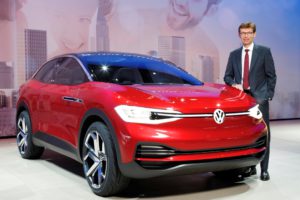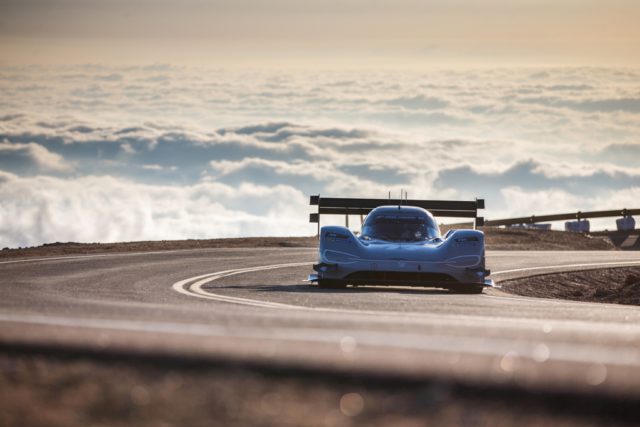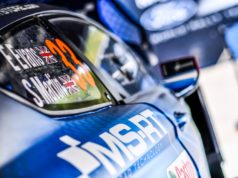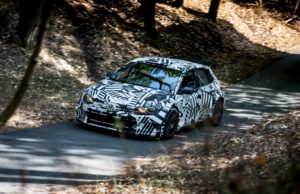The Volkswagen I.D. R Pikes Peak made history with its record-breaking run at the Pikes Peak International Hill Climb on 24 June: the first fully-electric racing car from Wolfsburg conquered the 19.99-kilometre route in 7:57.148 minutes. However, the 500-kW (680-PS) I.D. R Pikes Peak is far more than just a record holder – it is the sporty ambassador for the I.D. family, Volkswagen’s range of fully-electric production vehicles, which will hit the market from 2020 onwards.
In an interview, Dr. Frank Welsch, Member of the Board of Management of the Volkswagen Passenger Cars Brand with responsibility for “Technical Development”, speaks about what this means for the future, the challenges faced when developing the I.D. R Pikes Peak, and the strategy behind competing at the Pikes Peak International Hill Climb.

Dr. Welsch, the I.D. R Pikes Peak was one of the stars at the famous Concours d’Elegance in Pebble Beach, USA. A few weeks down the line, how do you assess the record-breaking run on Pikes Peak?
I am still very proud of the fantastic efforts of the entire Volkswagen Motorsport team. And you’re right, only now that the dust has settled a little is it possible to take in the enormity of this success. The project had a very tight timeframe, the entire development was completed within a matter of months, and the race itself lasted less than eight minutes – however, the success is of long-term importance. I believe that the first victory for an electric race car against conventional drivetrains is of ground-breaking proportions – similar to four-wheel drive in rallying.
The success on Pikes Peak was more than just a motorsport victory and record. How would you assess the achievement in terms of its overall importance for Volkswagen?
Volkswagen is following a clear E-strategy and will launch an entire range of fully-electric vehicles with the name I.D. in 2020. The I.D. R Pikes Peak is the sporty ambassador to this new generation of vehicles and not only underlines our clear commitment to electromobility, but also the huge potential performance that E-drive can offer in the future.
Was the decision to field the newly-developed I.D. R Pikes Peak at the Pikes Peak International Hill Climb taken for strategic reasons?
Yes! It is the most famous hill climb in the world. The name is mentioned in the same breath as many other iconic motorsport venues – such as Le Mans, Monte Carlo and Daytona. We were obviously excited about the opportunity to take on a race of this kind with a fully-electric racing car for the first time. And the fact that we only had one attempt there. There is no second run, no pit-stop strategy to adjust anything. No, everything has to be spot on – a great challenge for developers.
Speaking of developers, how much leeway did the regulations give them?
That was what made it so exciting and spectacular: Pikes Peak offers great possibilities because the regulations impose hardly any restrictions. Particularly in the Prototype class. We were left to our own devices and gave our engineers a blank sheet of paper. In terms of the race itself, that meant establishing what is important? Is it of central importance to have as little weight as possible? And, given that, how large and heavy can the batteries afford to be? In the case of the latter, it was important to find an ideal compromise between range and optimal performance. On top of that, you had the aerodynamic set-up and the altitude, at which the race took place – all of these factors interacted and had to be taken into account. It was a big testing ground and development laboratory.

E-mobility is often accused of being relatively emotionless. Can a success like the one on Pikes Peak change that?
Motorsport has always served as a test laboratory for future technology and stirs emotion and excitement among fans and protagonists alike. The I.D. R Pikes Peak is the best example of this: its extraordinary design, pioneering technology and enormous performance set the pulses of many fans racing. I followed the race on livestream in Autostadt, together with more than 500 motorsport fans; that was pure excitement and emotion – two elements that are obviously also radiated by our future I.D. family.
What does the project mean for the I.D. family, with regard to the transfer of technology?
There is always a close exchange of knowledge between production development and the colleagues in motorsport. A few specific examples of the development of the I.D. R Pikes Peak acquiring important knowledge for production are the strategies for and effects of the rapid charging process for the batteries, the optimal management of the energy recuperation, and the 3D printing of ultra-light materials, some of which had to withstand extreme loads.
How did the knowledge transfer take place?
In the field of high-voltage technology, the motorsport colleagues benefitted from the knowledge of the specialist departments for E-mobility in Wolfsburg and in Braunschweig – for example, when designing the battery modules or shielding highly-sensitive signal cables in the high-voltage environment of the I.D. R Pikes Peak, which reaches several hundred volts in strength. On the other side, the colleagues in Wolfsburg had a great interest in the use and durability of the racing car’s ultra-light carbon fibre/Kevlar chassis.
In your opinion, how is the future looking for motorsport with electric drive?
The race on Pikes Peak was a very successful introduction to motorsport with E-drive for Volkswagen. And we have many more ideas for further outings with the I.D. R Pikes Peak. Furthermore, we have for some time now been looking into possibilities for electric racing cars, such as the FIA World Rallycross Championship, in which electric racing cars will line up in the future. The question of what challenges Volkswagen will take on next remains a very exciting one.

































